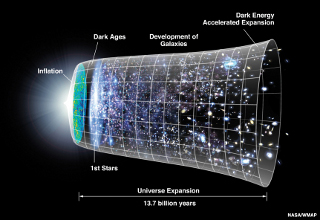The study of dark energy is driving some of the future experiments in the infrared. Dark energy was discovered in the mid-1990s. In 2011, the Nobel Prize in Physics was awarded for the discovery of the accelerating expansion of the Universe through observations of distant supernovae. One discusses dark energy as the potential source of that acceleration.
Wide-Field Infrared Survey Telescope: WFIRST will perform three surveys to provide scientists with data that can help us to understand the unknown entity dark energy. The High Latitude Spectroscopic Survey will measure redshifts and positions of galaxies. The Type Ia Supernovae Survey will measure absolute distances using Type Ia supernovae as standard candles. The High Latitude Imaging Survey will measure the shapes and photometric redshifts of galaxies and galaxy clusters.
Credit: NASA / GSFC
Dark energy is similar to dark matter, in that you infer its presence. If you have heat energy, you know what the source is; likewise for mechanical energy, electrical energy, kinetic energy, potential energy, etc.; but for dark energy, you don’t know the source. Measuring the properties of dark energy is becoming a driver for many of the big experiments, such as the Wide Field Infrared Survey Telescope (WFIRST). People are also finding novel uses of projects designed for other purposes, so, for instance, the James Webb Space Telescope is now set to make a major contribution to the study of dark energy.
The discovery of dark energy rests on the discovery that the Universe is accelerating, using the brightness of supernovae at different distances as standard candles. JWST will improve the precision of the luminosity measurements by removing some uncertainties in the effects of dust. JWST will also study very distant and very faint galaxies. Supernovae in those objects will be found, and redshifts of the galaxies will be obtainable (probably using large ground-based telescopes). Thus, we will know the distance of the supernovae. The study of dark energy has led to a very precise calibration of luminosity versus distance, extending the reach of the distance calibration. Since looking at galaxies at great distance is the equivalent of looking back in time, it will be possible to measure the acceleration of the Universe as a function of age of the Universe, which will get to the heart of the biggest observational questions about dark energy.
WFIRST will carry out an all-sky survey of infrared sources that will detect galaxies much further away than were found with Infrared Astronomical Satellite (IRAS) for instance. As the Universe expands, it is thought that the gravitational pull of the dark matter brings objects together. In the case of galaxies that reside in clusters, the clusters will change size as the Universe ages and expands. WFIRST will determine the changes in clustering of galaxies, an observation that can be directly related to the properties of dark energy. WFIRST will also detect very distant supernovae that will contribute to our understanding of dark energy.


